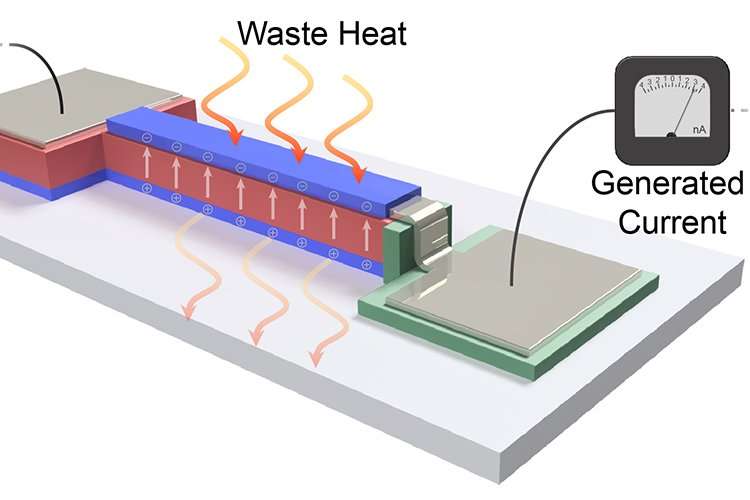Nearly 70 percent of the energy produced in the United States each year is wasted as heat. Much of that heat is less than 100 degrees Celsius and emanates from things like computers, cars or large industrial processes. Engineers at the University of California, Berkeley, have developed a thin-film system that can be applied to sources of waste heat like these to produce energy at levels unprecedented for this kind of technology.
The thin-film system uses a process called pyroelectric energy conversion, which the engineers’ new study demonstrates is well suited for tapping into waste-heat energy supplies below 100 degrees Celsius, called low-quality waste heat. Pyroelectric energy conversion, like many systems that turn heat into energy, works best using thermodynamic cycles, kind of like how a car engine works. But unlike the engine in your car, pyroelectric energy conversion can be realized entirely in the solid state with no moving parts as it turns waste heat into electricity.
The new results suggest that this nanoscopic thin-film technology might be particularly attractive for installing on and harvesting waste heat from high-speed electronics but could have a large scope of applications. For fluctuating heat sources, the study reports that the thin film can turn waste heat into useable energy with higher energy density, power density and efficiency levels than other forms of pyroelectric energy conversion.
“We know we need new energy sources, but we also need to do better at utilizing the energy we already have,” said senior author Lane Martin, associate professor of materials science and engineering. “These thin films can help us squeeze more energy than we do today out of every source of energy.”
The research will be published April 16 in the journal Nature Materials. The research was supported, in part, by grants from the Army Research Office and the National Science Foundation.
Pyroelectric behavior has been known for a long time, but accurately measuring the properties of thin-film versions of pyroelectric systems has remained a challenge. A significant contribution of the new study is to demystify that process and improve the understanding of pyroelectric physics.
Martin’s research team synthesized thin-film versions of materials just 50-100 nanometers thick and then, together with the group of Chris Dames, associate professor of mechanical engineering at Berkeley, fabricated and tested the pyroelectric-device structures based on these films. These structures allow the engineers to simultaneously measure the temperature and electrical currents created, and source heat to test the device’s power generation capabilities – all on a film that’s less than 100 nanometers thick.
“By creating a thin-film device, we can get the heat into and out of this system quickly, allowing us to access pyroelectric power at unprecedented levels for heat sources that fluctuate over time,” Martin said. “All we’re doing is sourcing heat and applying electric fields to this system, and we can extract energy.”
This study reports new records for pyroelectric energy conversion energy density (1.06 Joules per cubic centimeter), power density (526 Watts per cubic centimeter) and efficiency (19 percent of Carnot efficiency, which is the standard unit of measurement for the efficiency of a heat engine).
The next steps in this line of research will be to better optimize the thin-film materials to specific waste heat streams and temperatures.
“Part of what we’re trying to do is create a protocol that allows us to push the extremes of pyroelectric materials so that you can give me a waste-heat stream and I can get you a material optimized to address your problems,” Martin said.

Stalins-Mustache on April 17th, 2018 at 15:23 UTC »
I am about to graduate with a mechanical engineering degree and I just want to mention that the efficiency of pulling energy from a system, like computer waste heat for example, is 1 - air-temp/computer-temp . Which means if your computer is putting out air at 40 c (104 F / 313 K), then you can only recycle 7% of the energy coming out of the computer and that is a theoretical maximum, so it will be even lower in reality. And it computers generally use a pretty low amount of energy anyway. This is much better applied to industrial waste heat that reaches extremely high temperatures, not low temperature waste heat of electronics in houses.
mkmxd on April 17th, 2018 at 14:23 UTC »
So a Carnot cycle with cold and hot temperatures of 293 Kelvin and 393 Kelvin would have an efficiency of around 25%, then this pyroelectric energy conversion in the same temperatures would have 5% efficiency. Other ways to use heat would be thermoelectric heat conversion, that has the efficiency of 2-5 %. Using waste heat for ORC generator could me more profitable as those can have efficiency up to 20%. Piezoelectrics is another way to convert but the efficiency is only around 1%
source: BCS, I., 2008. Waste heat recovery: technology and opportunities in US industry. [Online] Available at: https://www1.eere.energy.gov/manufacturing/intensiveprocesses/pdfs/waste_heat_recovery.pdf
edit 1: the formatting edit 2: as u/brb1031 pointed out, i had the wrong efficiency for my carnot cycle. edit 3: more sources for the other conversion methods for low temperature waste heat. These are paywalled but if you are student like i am, your school might provide access. ORC: Renewable and Sustainable Energy Reviews Volume 15, Issue 8, October 2011, Pages 3963-3979 Low-grade heat conversion into power using organic Rankine cycles - A review of various applications(Article) ISSN: 13640321
Thermoelectrics: Renewable and Sustainable Energy Reviews Volume 24, 2013, Pages 288-305 Nanoengineering thermoelectrics for 21st century: Energy harvesting and other trends in the field(Article) ISSN: 13640321
Using heat to produce cooling with Absorption: Applied Energy Volume 139, February 01, 2015, Pages 384-397 Thermo-economic analysis of steady state waste heat recovery in data centers using absorption refrigeration(Article) ISSN: 03062619
wwarnout on April 17th, 2018 at 14:09 UTC »
One of the main sources of waste heat is combustion (power plants, motor vehicles, etc.). Applying a technology to these sources could yield a great deal of energy otherwise lost to heat.